| |
|
|
©By: John T. Blair (WA4OHZ)
 1133 Chatmoss Dr., Va. Beach, Va. 23464; (757) 495-8229
1133 Chatmoss Dr., Va. Beach, Va. 23464; (757) 495-8229
Originally written: circa 1989
Last update:  June 1, 2009 - Added pictures and reworded parts.
June 1, 2009 - Added pictures and reworded parts.
In part 1, I covered most of the basic hand tools. Now lets move on to some more specialized tools that will come in very handy for troubleshooting and diagnosing problems. These are usually be purchased as needed.
|
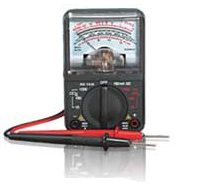
Analog Multimeter
|
First in my book is an analogue multimeter. The digital ones are OK but I
prefer the old fashioned ones with the real meter movement. Probably the best
source for one of these is Radio Shack. A good meter can be purchased for about
$30 on sale. This will allow you to measure voltage (AC or DC), current, and
resistance. This tool is a must for trouble shooting any electrical problem.
I know most mechanics just use the Test light (little screwdriver looking
thing with a light bulb
|
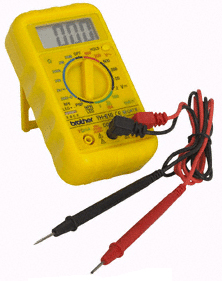
Digital Multimeter
|
|
in it, but that just doesn't cut it for me although it is better than nothing). It
is pretty much a go, no go, tool.
|
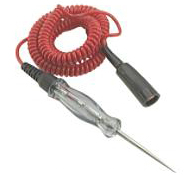
Test Light
|
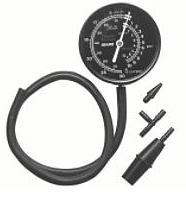
Vacuum gauge
|
A vacuum gauge is used to measure the vacuum in the car's engine and they are
great diagnostic tools. Many old timers use them for setting carbs and timing. Like a compression gauge, the vacuum gauge lets you get a feel for what is happening in the engine, like sticking valves, ignition and valve timing, or if any of the valves are burned, and more. They can also be used for checking fuel pressure on low pressure (non-fuel injected systems).
|
|
Another vacuum related tool is the MityVAC or Vacuum Pump Kit. In addition to having a vacuum gauge, it has a trigger grip to allow you to create a vacuum for
testing all kinds of diaphragms, etc. as well as read vacuum and you can see how
long a part holds a vacuum. They cost from about $25 to about $70 depending on
what accessories you get with in. Many come with a great book on how to use on
in troubleshooting engine problems. The newer the car is the more vacuum operated
controls there are, like the heating system.
|
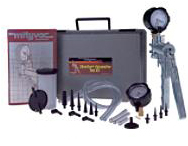
MityVac or Vacuum pump
|
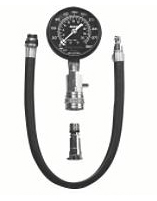
Compression Gauge
|
A compression gauge is used to check how much pressure can be created in a
cylinder.
A compression test, along with a vacuum gauge, is about the only way of telling if an engine has a blown head gasket, bad valves, or rings without removing the head. If you buy one, spend the extra money and get the one that have a long flex hose and actually screw into the spark plug holes instead of the inexpensive ones you have to push on and hold. In many of the newer cars you can't get these inexpensive ones to the spark plug holes.
|
|
For tuning up older cars with points, (pre 1980 - Before Computers), you will need a
timing light and a dwell/tach meter. These meters allow you to tell
what the engine revolutions per minute (RPM) are so you can adjust the carburetor,
and help you set the ignition points.
|
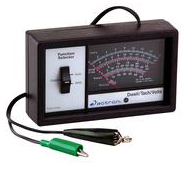
Dwell Tach Meter
|
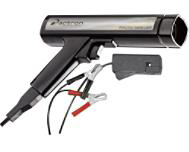
Timing Light
|
For setting the timing, you'll need a Timing Light. I prefer the DC powered
timing light (about $50). This type of timing light clips onto the cars battery to
power the light, and clips onto #1 spark to pickup when #1 spark plug fires. This
triggers its high intensity light which can be seen even on a sunny day. The dwell
meter is used to set the points and the tachometer is used to set the engines idle
speed.
|
|
For newer cars, post 1980 you will need to be able to interface to the onboard computer. The computers store information about how the various sensors are working. When something isn't working correctly, the computer sets a code, and turns on the Check Engine Light (CEL) or Maintenance required Light (MIL). From 1980 thru 1995 car manufacturers used a system called "On Board Diagnostics". Manufactures were able to do as they please. For example, GM products required jumpiring 2 pins on a connector under the dash, turn the ignition key to the "run" position and the codes would blink out on the CEL.
Chrysler was user friendly, you turned the ignition key from "off" to "run", than back off, and repeated this 3 times. The 3rd time, you leave the key in the run position and the codes would blink out on the CEL.
Other manufactures required external equipment. Ford required a special tool for this (usually about $35) that exercised the various servos and check the sensors, then it displayed the codes by blinking them out on a light on the tool.
Volvo and others didn't provide any way for a layperson to get the codes on some of their cars.
|
|
In 1996 manufactures went to "On Board Diagnostics II". This set a standard on the interface connector, and the error codes, and left some codes for the manufacturer to define. To access the error codes, you'll need an ODB II code reader at a minimum. These can be purchased for about $50, like the Actron PocketScan. They only read and output the codes on a 1 line screen and usually have provisions to reset the codes. You will have to look up the code numbers in a book just like you have to for and ODB system.
|
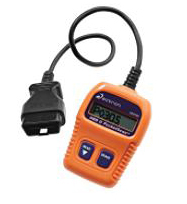
Actron Pocket Scann ODBII reader
|
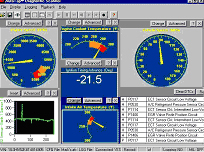
Autotap display
|
There are more complex scanners available and their cost is proportional to what it can do. Actron's top end unit is about $500 while others go up to $4,000, a little to much for the hobbyist. There are some vendors that sell interface cables and software that will run on your laptop. One such system is made by
autotap.com). These more expensive systems will allow you monitor a many of the parameters real time, retrieve error codes, and reset codes. These typically run from $300 to over $500.
|

3 Jaw Puller Set
|
Moving on to some more specialized tools, inevitably you will need a couple of gear
pullers (2 and or 3 jaw) for removing pulleys and gears from things. I'd suggest that maybe you get a 3 jaw puller set. Otherwise wait until you need the puller and buy it against the job.
|
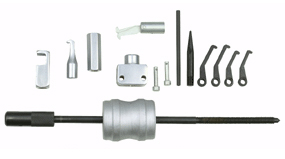
Slide Hammer Puller
|
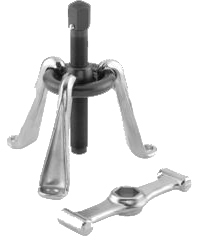
Hub Puller
|
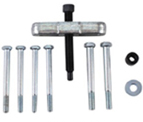
Steering Wheel Puller
|
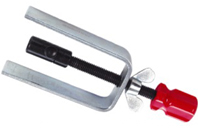
Steering Wheel Lock Plate Puller
|
|
A hub puller is quite large and it bolts to the hub for removing hubs from tapered axle shafts. The slide handle puller are used for pulling axels, pulling bearings and races, etc. (Harbor Freight has a slide hammer puller set for about $33.) There are special pullers for AC compressor clutches, power steering pump pulleys, etc. Pullers for things jobs like Pitman arm pullers, steering wheels
pullers, and steering wheel locking plate pullers. These last three are relatively inexpensive (under $15). I suggest that you purchase these as you need them.
Now that's what I call a pretty nicely stocked tool box. Unfortunately, we
have an expensive hobby and now we start filling our garage, not just the
tool box, with tools. These tools will also be a little more expensive.
|
|
An air compressor and the associated air tools, while not necessary, are a great time saver and make working on car a lot easier. One of the most important jobs in restoring a car, is fighting rust. When I restore a car, every metal part is removed, cleaned and painted. So here again an air compressor will pay for itself. I would not recommend anything smaller than a 4hp compressor with a 20 gallon accumulator. I grew up with one like this, my dad has had his Craftsman compressor for over 20 years. But it has trouble keeping up with the sanders, sand blasters, etc. So when I went to purchase mine, I went up one size, to a Craftsman 5 hp with a 30 gallon tank (it cost about $500). The rule of thumb is the "bigger the better", but your pocket book and available space will control your spending.
|

Compressor
|
|
Compressors of less than 4hp use 115V while the 4hp and larger use 220V. If you opt for a larger one, you might have to run a new power line from your service panel.
The horse power (hp) rating is the rating of the electric motor (i.e.. 5 hp., 10 hp., etc.). Lately, the marketing departments of the various compressor manufactures have been playing games with the hp ratings. It seems that they are rating them based on the maximum current the motor will draw (when starting) and not the running current. So beware. 1 hp is about 750 Watts. So a 5 hp motor should consume about 5x750=3750 Watts or 3.7 Kilowatts (KW). To calculate the current required by the motor divide the Watts by the Voltage (either 115 or 220). So a 5 hp motor will draw at least 3750/115 = 32.6 amps on a 115V circuit, or 3750/220 = 17 amps on a 220V circuit. This assumes that the motor is 100% efficient, which it isn't. House hold wiring usually has 2 types of circuits - the 110V (also referred to as 115V or 120V) used for most electrical lighting and small appliances. The maximum a 115V circuit will be rated for is about 30 amps and requires a special outlet and plug. Heavy appliances like an electric dryer, water heater, and stove all usually run in a 220V circuit. So you see that a 5 hp compressor will require a 220V circuit in your shop.
To help dry the air (remove moisture), you will need a dryer attached to the output
of the compressor. My compressor sits by the front of the garage and I have 50' of
air hose connected directly to the dryer. Originally the dryer was connected directly
to the compressor and consequently could not pull any moisture out of the air. To
condense the moisture out, there must be some distance between the output of the
compressor and the dryer, 2 inches just didn't hack it. I got some copper tubing
and wrapped it around a 2 liter Coke bottle. I connected 3 foot length of air hose
to each end of the coil with one end going to the output of the compressor and the
other end going to the dryer. This alone pulls a lot of water out of the air.
In addition, I can submerge the coil in a bucket of water to help cool the
air even more.
|
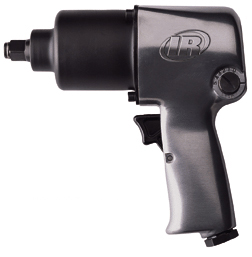
Impact Wrench
|
Now that you have a compressor, you have an excuse to get some of those nice air tools
you've been looking at, like a 1/2" drive impact wrench (from $40 up). This
really makes changing tires easy and reduces the busted knuckles when trying to undo a
really rusted bolt. (Note, I purchased a 2nd 1/2" impact wrench. It's a Champbell
Hausfeld Professional PL1502 for about $65 from Northern Hydraulics. It has
a lot more oomph of than the cheap $30 guns. I love it, it has replaced my cheap impact wrench as my work horse.).
|
|
Another great air tool is a 3/8 drive ratchet (about $30), and
I don't know how I ever lived without it. No more hand cranking on the ratchet, just press the trigger and it does all the work! One word of caution though, Don't use it to break nuts and bolts loose. If you do, you will drastically reduce its life span. I broke the gears on my first one, trying to break a bolt loose. Use either an impact wrench or a manual ratchet to break bolts loose.
|
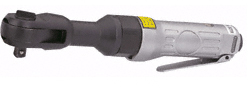
3/8" Drive Air Ratchet
|
|
Also, DO NOT use an impact wrench or air ratchet to fully tighten nuts and bolts. They give no feed back or feel and it is easy to break bolts off with them. If using to run the nut or bolt down, always set the tool to its lowest power setting and stop when the impact wrench start to make the familiar banging sound, or the air ratchet starts to pull in you hand. Then switch to a regular ratchet or torque wrench to finish the job.
|
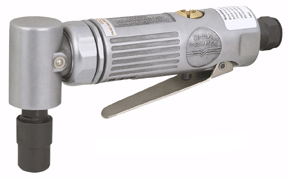
Angle Die Grinder
|
A 1/4" die grinder ($25) is a high speed tool and comes in straight and angled. I bought an angled grinder and an arbor and a cutting wheel. This makes short work for cutting off bolts and such. It can also be used to cut sheet metal - like a section from a fender. There is also a rubber disked arbor that you can attach a 3" sanding pad for it and some stick on 80 grit sandpaper. There are also various cutting burrs and grinding stones.
|
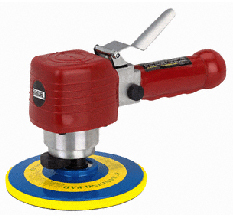
Dual Action Sander
|
For doing body work a dual action "DA" sander (about $40) and an inline sanders (about $40) are real time savers.
|
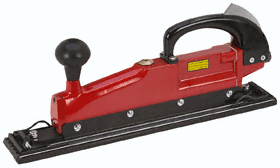
Inline Sander
|
|
You might want some paint guns. Since the primer is relatively thick, a pressure
feed gun is usually used. This type gun lets the compressed air into the paint tank to pressurize it, thereby forcing the paint out. You can skimp on the cost of this gun as the primer will get sanded and smoothed. My gun for priming is an inexpensive Sears pressure/siphon gun (found at a yard sale for $5).
For painting the top (color) coats a siphon feed gun is used. These guns let the air blow past the pickup tube, creating a vacuum and sucking or siphoning up the paint. These guns are more expensive; mine is a SEARS and cost about $70. A professional gun like a Binks can start at about $150.
|
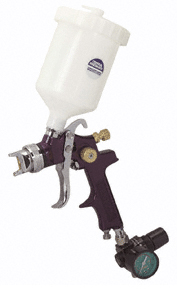
Gravity Feed HVLP Spray Gun
|
Relatively recently (since about 1990) a new type of gun has hit the market, a High Volume Low Pressure (HVLP). A true HVLP system contains the spray gun and a turbine
to provide the air. They usually contain a heater to dehumidify the air also. But
these can get expensive ($500ish).
HVLP guns are supposed to reduce over spray, and put more paint on the surface. You
can now find HVLP guns that can be driven by a standard compressor. I got a Harbor Freight one a couple of years ago for Christmas. I've used it quite a bit, and I like it better than any of the other spray guns I have.
|
|
There is also the Powder coating systems. However, for these you need an oven to cook the parts in after they have been sprayed. This is great for small parts as the powder coating hold up a lot better than traditional paint.
|
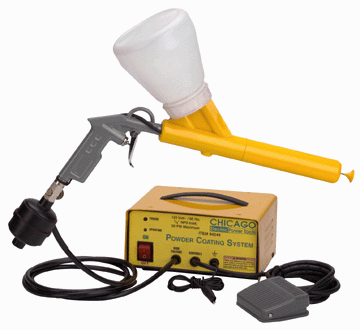
Powder Coating System
|
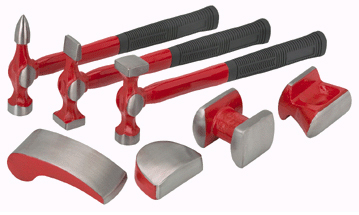
Body Working Tools
|
Speaking of body work, you can't do much without a set of hammers and dollies. These are used to bang out dents and reshape metal panels. Harbor Freight has a nice set of body hammers and dollies for under $20.
|
|
For cleaning paint and rust off of metal parts I use a 4" grinder (from $40 to $100). You need to be very carfull with these as they are high speed (10,000 rpm).
When they grab, they will really jump, so be sure you have a good hold on them all the time.
The grinding stone can be removed and replaced with a knotted wire brush.
Unfortunately, these brushes are pretty expensive (about $15 each) they are
the only ones rated to handle the 10,000 + rpm's of the grinder. For
relatively large areas, this high speed wire wheel does a better job than
paint stripper. I purchased an inexpensive one for $40 from Harbor
Freight.
|
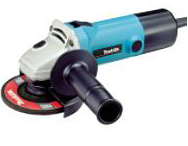
4" Angle Grinder
|
|
My dad borrowed and loved it, so he bought a Makita for $55.
However, we both like the one from Harbor Freight better. The 2 drawbacks
to the Makita are, 1 - the arbor size is metric M10x1.25. Most discount
houses sell the standard 5/8" x 11 brushes but very few handle the
M10x1.25. Consequently, getting the wire wheels is harder and more
expensive. The second problem is the Makita's safety guard is screwed to
the case and cannot be rotated. Many times we wanted to move the guard
around to allow better access when cleaning a part. When using these
grinders, you should wear some sort of eye protection. I've purchased a
face shield for about $12 from Northern Hydraulics. Since I wear glasses,
goggles tend to fog up. You should also use some kind of hearing
protector. I bought a pair of "Mickey mouse" ears from Northern Hydraulics
for about $8. Finally, you should wear a pair of leather gloves. I've had
the wire wheel get away from me and nick my hands. It took forever to
heal, and left some nice scars.
|
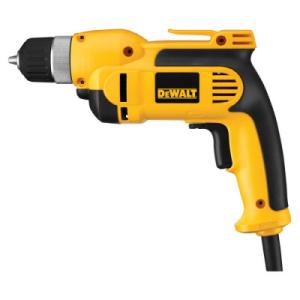
Corded Drill
|
In addition to the high speed grinder, the 3/8" (VSR) electric drill can be
use to clean parts by chucking up a wire wheel. The wire wheels are about
$5 and an arbor to hold the wheel is about $2.
|
|
For small parts or places that the grinder can not get to, a
sandblaster is great! I started with a siphon blaster with a 50
pound sand tank (from $50 to $100). I moved up to a Harbor Freight table top
Blast Cabinet and to a pressure blaster. For more information
check out my article on
media blasting.
I love the Harbor Freight plastic cabinet. My only complaint with it is
that the pick up tube, a short piece of pipe that sits in the tank, doesn't
stay put. As you use the tank the tube floats to the top of the sand and you
have to push it back down. What I did was to make some small aluminum straps
to hold the tube in the hopper. The straps were pop riveted to the box.
|
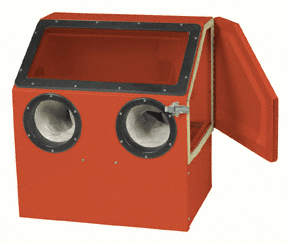
Blast Cabinet
|
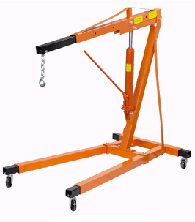
2 Ton Shop Crane
|
If you plan on doing any major work like pulling an engine or pulling a body
off a chassis, an engine crane is a must. I purchased mine, a 2 ton
hoist, for about $200. While these can be rented, I figured I had to pull and
replace the engine and the body of my Morgan, and pull and replace the engine
and body of my '75 Bricklin. At about $35 per day rent, I could just about
purchase one for the rental fee, so I did and been saving money ever since. Since
you don't need the engine crane all the time, to cut down on the space it requires, I disassemble mine and tie all the parts against the wall of my garage
when not in use.
|
|
A hydraulic press is a useful item although expensive. While you can send
the work out to be done, unless you know someone, it can get expensive.
Depending on the type of work you are doing, this will be one of the least used
tools in your shop. You use them to press on or off Universal Joints, bushings,
and bearings. I had to pay $30 to have the old bearings pressed off and a new
bearing pressed into the steering knuckle of my Voyager van. Since I've got 2
Voyagers and had to do the job to both, that's 4 times. Almost the cost of a
press. However, it's nice to be able to press bearings on and off when you need
to. The down side is that you're starting to fill an a lot of garage floor space
with these big tools. So maybe for the few times you need it, it's better to pay
to have the press job done. Harbor Freight as several nice presses for about $120 - $220.
|
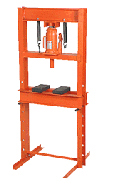
Shop Press
|
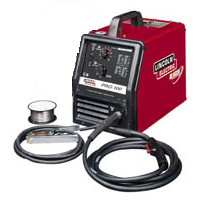
MIG Welder
|
Another item is a welder. There are 3 basic types of welders:
oxy-acetylene, arc, and MIG or wire feed. While the MIG (or wire
feed) welder is the most expensive of the 3. MIG stands for welding for
dummies! Not really it stands for Metal Inert Gas. I would suggest a MIG
welder for an initial investment. But is the easiest to learn to use. Most
welding on a car is replacing thin sheet metal panels. This is what the
MIG does best. The MIG welder doesn't generate the heat the other 2 welders
do. The wire feed feature makes welding easier for the hobbyist use. I'm
purchased a Lincoln SP100 MIG welder for about $600. To add the gas
regulator, bottle, hood and gloves cost about $200 more. The MIG and the
wire-feed welders are the same unit. The difference is for MIG you add the
gas regulator and bottle of gas.
|
|
There is a different sleeve that goes inside the cable that feeds the wire also to handle the different size diameter of the welding wire. The MIG wire I use is about .023" while the gas less wire is has flux in it core and is about .035". If you decide to purchase a MIG welder, look for one that has continuously variable wire feed speed and voltage settings vise the 4 to 6 click stop settings. This way, you can adjust the machine to fit you and you don't have to learn vary your welding to meet the machine.
I must admit that my dad already has the oxy-acetylene (with the 5 foot
tall tanks) and an arc welder so I have access to them and haven't had to
buy either of these.
|
|
Taking a quick look at oxy-acetylene welders. What are they good for? A very
good welder can weld about anything with one of these units, but it takes a
long time to become that good. Due to the heat generated, it is very ease to
warp a thin sheet metal panel on a car. The two things that are
nice about oxy-acetylene welders, is the heat and cutting. If you need to bend
or shape a piece of metal, you can get it cherry hot and then bend or shape it
a lot easier than doing it cold. Another nice thing about the heat, is if you
have a nut or bolt that doesn't want to move, in many cases you can use the
"hot wrench" technique. Get the nut or the metal surrounding the bolt hot. This
heat will help loosen the nut or bolt. Finally, there is the cutting torch
aspect. While the cuts aren't the smoothest it does cut metal nicely and quickly.
|
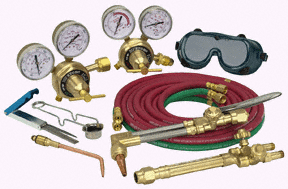
Oxy-Acetylene Welder
|
|
I find that many times I need to cut up something, like a car that my friends
and I are stripping. To move my dad's 5 foot tanks from his place to mine is a
real chore, and to move some of the things I'm working on to his place is even
harder. Consequently, I'd prefer a slightly smaller set of bottles. Something
in the neighborhood of 40 to 60 cubic feet. This setup has the advantage of
portability. The only drawback is that the bottles of gas don't last as long.
It's a real pain to run out of gas on a Friday night and not be able to use the
equipment until Monday night after the welding suppliers open Monday.
One final note on oxy-acetylene, if you get a setup, be sure to get flame arrestors.
These connect to the hoses, and are designed to keep the flame from walking back
into the lines and causing the tanks to explode.
Welding can be very useful, but like a lot of tools (especially electric saws) it
can be very dangerous. Look around where you are going to weld. You don't want
anything that is flammable near by. If you are a home hobbyist, try to do all you
welding and cutting outside. You don't want the sparks to catch something on fire
in your garage. Also be careful when welding on a car. Again, look at what you
plan on welding, both sided. Don't try to weld on the bottom of the floor pans,
and still have the seats, carpet, or insulation material in place. They will catch
on fire.
If you decide to purchase any type of welder, check with your local Vocational
Technical Schools, or Community Colleges. Many offer welding courses. These are
definately worth the cost. You will got through a lot of gas, electricity, and
metal learning to weld. All this is covered in the cost of the class. Plus you
have an instructor to help you with the technique.
In closing, the tools just mentioned represent quite a sizable investment
and will start to set up a very nice work shop. You may not need or want
all the tools I've described here. But you now have an idea of some of the
tools that are available and what they are used for. You don't have to go
out and purchase all the tools at once. Keep a list of desired tools
prominently displayed or just hand it the your wife, girl friend and kids
(or all three). There is always a tool for every gift giving occasion.
If you aren't already familiar with the companies I've mentioned,
here are the names of several mail order tool houses. If you don't have
their catalogues, simply give them a call and they'll send you one. They
make great reading. You can spend hours just drooling over all the tools
you don't have and dream of how much easier life would be if you only had
that tool.
If you really get into body work, you'll probably have to do some metal cutting. There is a whole nother world of tools for cutting metal.
 Enjoy your Car
Enjoy your Car
 John
John
Harbor Freight Tools
3491 Mission Oaks Blvd
P.O. Box 6010
Camarillo, Ca. 93011-6010
 (800) 423-2567 - They have a wide range of items from shop
rags to milling machines.
(800) 423-2567 - They have a wide range of items from shop
rags to milling machines.
Kitts Industrial Tools
22384 Grand River Ave.
Detroit, Mi. 48219
 (800) 521-6579 - They have a wide range of items.
(800) 521-6579 - They have a wide range of items.
Sears
Tool catalogue, Can be picked up at most Sears stores.
Norther Tools & Equipment
Return to the Index of Tech. articles
To email me with comments or
questions.
|
 1133 Chatmoss Dr., Va. Beach, Va. 23464; (757) 495-8229
1133 Chatmoss Dr., Va. Beach, Va. 23464; (757) 495-8229
 June 1, 2009 - Added pictures and reworded parts.
June 1, 2009 - Added pictures and reworded parts.































 Enjoy your Car
Enjoy your Car
 John
John
 (800) 423-2567 - They have a wide range of items from shop
rags to milling machines.
(800) 423-2567 - They have a wide range of items from shop
rags to milling machines.
 (800) 521-6579 - They have a wide range of items.
(800) 521-6579 - They have a wide range of items.